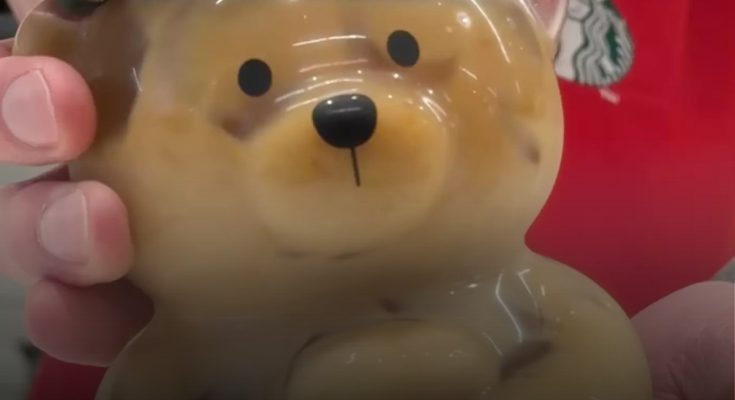Starbucks has been forced into damage control after the launch of its limited-edition “Bearista” Cold Cup set off a nationwide scramble, rapid sell-outs and accusations that some stores allowed staff to purchase stock before customers could, prompting a rare apology from the company. The 20-ounce glass collector’s cup, shaped like a clear honey-bear with a green lid and straw styled to look like a beanie, went on sale in U.S. stores on 6 November alongside the chain’s holiday drinks. It was priced at $29.95 and, in many locations, it disappeared as doors opened, with some customers reporting that their store received only one or two units. Starbucks said demand overshot its projections even though it had shipped the item broadly, and told disappointed fans that more seasonal merchandise would follow. “The excitement for our merchandise exceeded even our biggest expectations and despite shipping more Bearista cups to coffeehouses than almost any other merchandise item this holiday season, the Bearista cup and some other items sold out fast. We understand many customers were excited about the Bearista cup and apologize for the disappointment this may have caused,” the company said in a statement provided to multiple outlets.
The apology followed 24 hours of escalating backlash as videos and posts showed early-morning lines, disputes at counters and customers walking away empty-handed after driving to several stores before sunrise. In one clip amplified on TikTok and across X, a frustrated customer alleged that a Kroger-housed Starbucks in Indianapolis allowed employees to buy out the cups before opening; the poster said they arrived at 2 a.m., joined others queueing and watched staff take the inventory to the back. Starbucks did not confirm store-level details but acknowledged the broader shortage and said it anticipated more holiday merchandise, without specifying whether the Bearista cup itself would return.
The product, teased a day earlier on Starbucks’ Instagram, tapped into a fervent collector culture that has grown around the chain’s seasonal tumblers and cold cups. Enthusiasts who plan for limited drops described a sharper scarcity this time, with some stores telling would-be buyers that they never received stock or had already exhausted deliveries in pre-opening purchases. Comments under Starbucks’ official social posts captured the change in mood from excitement to exasperation: “I got up at 4am and drove to a location that said it would have this cup. I was first in line, and they didn’t have it. I drove to four more locations, none of them had it and said they never did,” one user wrote. Others accused the campaign of fuelling resellers. “This campaign has done nothing but fuel resale at absurd prices, feeding a market that shouldn’t even exist,” another comment said.

Soon after stores opened, secondary-market listings proliferated. Prices on resale platforms climbed well beyond retail, with examples documented in coverage ranging from hundreds of dollars to four-figure asks. Reports listed eBay posts as high as $275 and higher, with other outlets capturing screenshots of listings pushing $500 or more; some accounts cited speculative postings around $1,000 as the frenzy peaked. The spread in those figures reflects the opaque and fast-moving nature of collector resales, but the trend line was unmistakable: scarcity and hype drove a premium, and ordinary customers who queued early faced a choice between paying multiples or abandoning the hunt.
In isolated instances, tempers flared. Local clips from U.S. stores circulated showing heated exchanges and jostling around displays, with one incident in Houston described as a brawl by tabloid coverage that gathered millions of views. Starbucks did not comment on individual store disputes, and there were no widespread reports of injuries or arrests linked to the rollout, but the imagery underscored how the drop had crossed from a typical seasonal promotion into a cultural flashpoint for collectors and casual customers alike.
Within hours, the narrative hardened around two central complaints: that distribution was too thin even by limited-edition standards, and that store-level controls failed to prevent staff from buying items before the public. Some self-identified baristas on Reddit and in comment sections said their locations received “a handful” of units—two or three in some stores—while others reported allocations that sold out instantly once doors opened. Starbucks’ statement did not disclose per-store quantities or a national total, but the company insisted the Bearista cup was among its most widely shipped holiday merchandise items this season, a claim meant to rebut the view that the scarcity was engineered.
The flashpoint also exposed a structural tension in Starbucks’ merchandise strategy. Over the past decade, the brand has expanded aggressively into lifestyle products, with tumblers, cold cups and collaborations designed to travel across social media as much as they do in shopping bags. The collector community around those items can be a powerful marketing engine; product reveals reliably draw millions of views, and limited drops often produce queues and immediate sell-outs. But scarcity cuts both ways. When passionate collectors secure items and resell them at significant mark-ups, casual customers see a company stoking demand without building supply to match. When employees are perceived—fairly or not—to have an inside track, it corrodes trust at the counter. The Bearista episode bundled all of those dynamics into a single morning, magnified by the holiday calendar and the return of popular seasonal drinks.
Buyers’ accounts painted a picture of meticulous planning defeated by thin deliveries. Some fans said they called ahead to confirm stock or mapped routes to hit multiple stores at opening. Others recounted turning up in the dark to lines of dozens, only to be told a store had received one cup and that it had already been purchased. A number of posts accused employees of holding back inventory for themselves or friends. Starbucks’ apology stopped short of addressing those specific allegations; the statement neither confirmed nor rejected whether stores have policies restricting staff purchases on high-demand merchandise before opening, leaving individual licensees and in-store managers to interpret guidelines. The absence of that detail kept the controversy alive online, where calls grew for Starbucks to standardise release-day rules and to publish minimum per-store allocations for future drops.
Amid the backlash, some customers shifted attention to lookalike alternatives. Amazon search results for bear-shaped tumblers climbed in rankings, according to reports, with shoppers claiming they could find visually similar cups at a fraction of the price without queueing before dawn. That workaround may blunt some short-term frustration, but it does little to address the loyalty hit that comes when a flagship brand’s most visible holiday item becomes effectively unobtainable for ordinary customers. A few collectors defended Starbucks, noting that limited runs are, by definition, not guaranteed, and arguing that part of the appeal is the chase. Yet even those voices tended to call for clearer communication on stock numbers and restock plans.
On restocks, Starbucks has kept its language cautious. The company has pointed customers to “more exciting merchandise” arriving through the season but has not promised additional Bearista units. That hedged messaging leaves open several possibilities: that the company cannot reproduce the exact cup quickly enough to matter; that legal or supplier constraints cap output; or that Starbucks prefers to protect the mystique of the drop rather than dilute it with rolling replenishments. In the absence of specifics, speculation filled the gap, and resale prices remained buoyant over the weekend.
The timing of the debacle is awkward for Starbucks. The holiday window is a critical period for the chain, with red-cup giveaways, seasonal drink launches and collectible merch designed to drive both transactions and social chatter. This year’s drink line-up—returning staples such as Sugar Cookie and a heavily trailed Iced Gingerbread Chai—delivered its usual buzz. But the Bearista cup’s overshadowing effect meant much of the attention went to a product most customers could not buy, and to a supply-chain narrative that Starbucks was forced to rebut with an apology rather than leverage for sales.
The episode also lands in a year when Starbucks has faced scrutiny on multiple fronts, including unionisation disputes and questions about traffic trends in certain markets. While there is no direct link between those issues and a merchandise shortage, the customer-experience optics matter. For a brand built around the consistency of an everyday ritual, a high-profile product drop that devolves into queues, scuffles and accusations of unfair access can chip away at goodwill far beyond the collector niche. The apology acknowledges as much; it’s not only an expression of regret but an attempt to signal operational awareness without committing to a fix that could be difficult to execute quickly.
For customers who still want the Bearista, the practical options are limited. Some will watch store shelves in the hope of sporadic allocations, though there is no official guidance that more units are en route. Others will pay the premium on resale sites or settle for third-party lookalikes that mimic the bear-and-beanie silhouette. Many will simply move on to other holiday items. The outcry is likely to fade as the season advances, but the lesson will linger inside Starbucks headquarters: if a limited-run accessory becomes the season’s headline, it needs either enough stock to meet a substantial slice of demand or a release system seen as orderly and fair—preferably both.
Whether Starbucks changes approach will be evident in the next few weeks. A clearer pre-launch playbook would include store-level instructions on employee purchases, posted limits per customer, accurate public stock guidance and the sort of queue-management steps common in streetwear drops. The brand’s own statement emphasised breadth of distribution, which suggests supply chain and forecasting teams believed they had covered the risk. They did not. If Starbucks chooses to treat the Bearista as a one-off misfire in execution rather than the beginning of a more structured drop culture, the response will be incremental—nudges to allocations, tighter store rules, a promise of “more to come.” If, however, the company concludes that the upside of merch-led virality outweighs the reputational hit when stock runs dry, future releases will need a more transparent framework to protect staff and customers alike from the kind of scenes that dominated feeds this week. For now, the company has apologised, told fans more holiday merchandise is coming and left collectors to decide how much the hunt is worth.


